Gallery: Universe's Cosmic Microwave Background Revealed by Planck Observatory
Planck's All-Sky Map: Cosmic Microwave Background
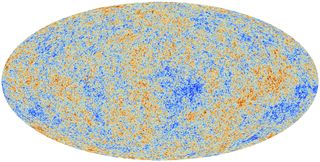
This image unveiled March 21, 2013, shows the cosmic microwave background (CMB) as observed by the European Space Agency's Planck space observatory. Among the discoveries: The universe is older than thought, 13.82 billion years old. The CMB is a snapshot of the oldest light in our Universe, imprinted on the sky when the Universe was just 380 000 years old. It shows tiny temperature fluctuations that correspond to regions of slightly different densities, representing the seeds of all future structure: the stars and galaxies of today. [Full story.]
How the Cosmic Microwave Background Radiation Reveals the Secrets of the Universe (Infographic)

The CMB radiation tells us the age and composition of the universe and raises new questions that must be answered. [Full story.]
Peculiar Features in Patterns of Ancient Light
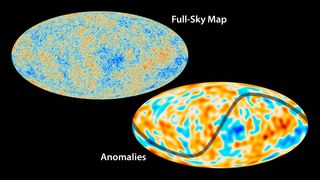
The Planck mission has imaged the oldest light in our universe, called the cosmic microwave background, with unprecedented precision. The results fit well with what we know about the universe and its basic traits, but some unexplained features are observed. Image released March 21, 2013. [Full story.]
The Story of Our Universe
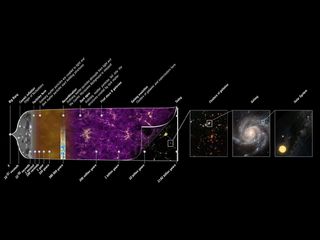
This illustration summarizes the almost 14-billion-year-long history of our universe. It shows the main events that occurred between the initial phase of the cosmos — where its properties were almost uniform and punctuated only by tiny fluctuations — to the rich variety of cosmic structure that we observe today, ranging from stars and planets to galaxies and galaxy clusters. Image released March 21, 2013. [Full story.]
Map of Matter in the Universe
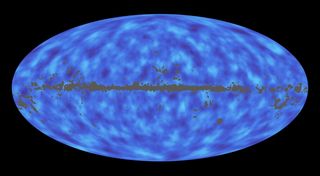
This full-sky map from the Planck mission shows matter between Earth and the edge of the observable universe. Regions with less mass show up as lighter areas while regions with more mass are darker. The grayed-out areas are where light from our own galaxy was too bright, blocking Planck's ability to map the more distant matter. Image released March 21, 2013. [Full story.]
Planck Spacecraft Artist's Concept
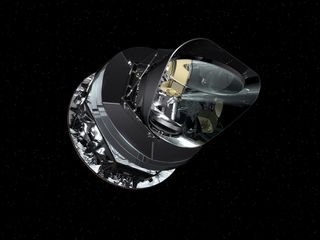
This is an artist's concept of the Planck spacecraft. Planck was launched with the Herschel spacecraft, though the two missions separated shortly after launch and operate independently from each other. Image released Jan 17, 2017. [Full story.]
Planck's Ingredients of the Universe
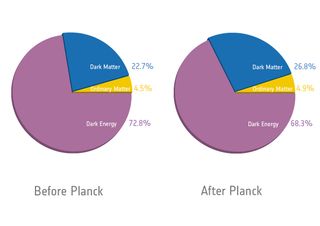
This European Space Agency graphic depicts the most refined values yet of the Universe’s ingredients, based on the first all-sky map of the cosmic microwave background by the Planck space observatory unveiled on March 21, 2013. Normal matter that makes up stars and galaxies contributes 4.9 percent of the Universe's mass/energy inventory. Dark matter occupies 26.8 percent, while dark energy accounts for 68.3 percent. [Full story.]
Get the Space.com Newsletter
Breaking space news, the latest updates on rocket launches, skywatching events and more!
Planck's All-Sky Map vs. Standard Model
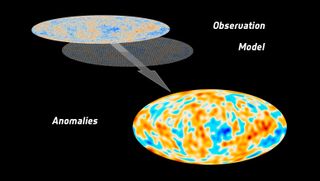
This European Space Agency graphic shows a map of the universe that depicts the anomalies seen when comparing the Planck space observatory's map of the universe's cosmic microwave background and the standard model of the cosmos. Image released March 21, 2013. [Full story.]
Cray XE6 Supercomputer "Hopper"
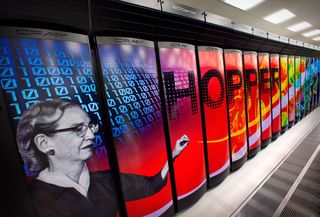
The bulk of the Planck computations were performed on the Cray XE6 supercomputer, named for computer scientist Grace Hopper, at the Department of Energy's National Energy Research Scientific Computing Center at the Lawrence Berkeley National Laboratory, Berkeley, Calif. Image released March 21, 2013. [Full story.]
Planck's All-Sky Map: Cosmic Microwave Background Anomalies

Two Cosmic Microwave Background anomalies hinted at by the Planck observatory's predecessor, NASA's WMAP, are confirmed in new high-precision data revealed on March 21, 2013. In this image, the two anomalous regions have been enhanced with red and blue shading to make them more clearly visible. [Full story.]
The Universe Comes Into Sharper Focus
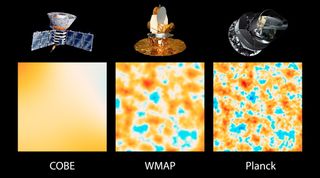
This graphic illustrates the evolution of satellites designed to measure ancient light leftover from the big bang that created our universe 13.8 billion years ago. Called the cosmic microwave background, this light reveals secrets of the universe's origins, fate, ingredients and more. Image released March 21, 2013. [Full story.]
Join our Space Forums to keep talking space on the latest missions, night sky and more! And if you have a news tip, correction or comment, let us know at: community@space.com.

Space.com is the premier source of space exploration, innovation and astronomy news, chronicling (and celebrating) humanity's ongoing expansion across the final frontier. Originally founded in 1999, Space.com is, and always has been, the passion of writers and editors who are space fans and also trained journalists. Our current news team consists of Editor-in-Chief Tariq Malik; Editor Hanneke Weitering, Senior Space Writer Mike Wall; Senior Writer Meghan Bartels; Senior Writer Chelsea Gohd, Senior Writer Tereza Pultarova and Staff Writer Alexander Cox, focusing on e-commerce. Senior Producer Steve Spaleta oversees our space videos, with Diana Whitcroft as our Social Media Editor.
